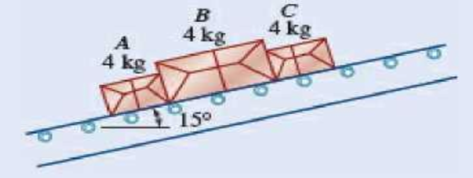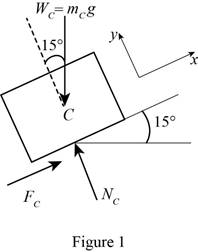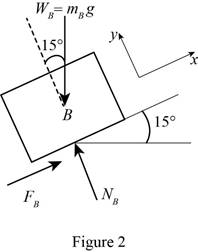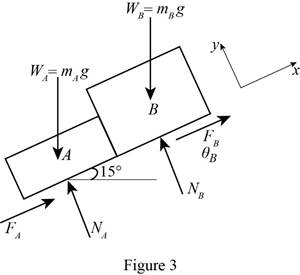
Three 4-kg packages A, B, and C are placed on a conveyor belt that is at rest. Between the belt and both packages A and C, the coefficients of friction are μs = 0.30 and μk = 0.20; between package B and the belt, the coefficients are μs = 0.10 and μk = 0.08. The packages are placed on the belt so that they are in contact with each other and at rest. Determine which, if any, of the packages will move and the friction force acting on each package.

Fig. P8.13
Find whether any of the package moves and the friction force acting on each package.
Answer to Problem 8.13P
The package C will
The friction force in the package C is
The packages A and B will
The friction force in the package B is
The friction force in the package A is
Explanation of Solution
Given information:
The mass of the package A, B, and C is
The static coefficient of friction between packages A and C and the belt is
The static coefficient of friction between package B and belt is
The kinetic coefficient of friction between packages A and C and belt is
The kinetic coefficient of friction between package B and belt is
Calculation:
Consider the acceleration due to gravity as
Consider Block C:
Show the free body diagram of the block C as in Figure 1.

Resolve the vertical component of forces.
Resolve the horizontal component of forces.
Find the maximum friction force
Substitute 0.30 for
The maximum friction force is greater than the friction force.
Therefore, the package C will
Therefore, the friction force in the package C is
Consider Block B:
Show the free body diagram of the block B as in Figure 2.

Resolve the vertical component of forces.
Resolve the horizontal component of forces.
Find the maximum friction force
Substitute 0.10 for
The maximum friction force is less than the friction force.
Therefore, the package B will
Find the friction force in the package B using the kinetic relation.
Substitute 0.08 for
Therefore, the friction force in the package B is
Consider Block A and B together:
Show the free body diagram of the block A and B as in Figure 3.

The normal force in package A is
The normal force in package B is
The friction force in package A is
The friction force in package B is
Find the total normal force in package A and B as follows;
Find the total friction force in package A and B as follows;
The maximum friction force in package A is
The maximum friction force in package B is
Find the maximum friction force
The maximum friction force is less than the friction force.
Therefore, the packages A and B will
Find the friction force in the package A using the kinetic relation.
Substitute 0.20 for
Therefore, the friction force in the package A is
Want to see more full solutions like this?
Chapter 8 Solutions
VECTOR MECH...,STAT.+DYNA.(LL)-W/ACCESS
- Note: Please provide a clear, step-by-step simplified handwritten working out (no explanations!), ensuring it is done without any AI involvement. I require an expert-level answer, and I will assess and rate based on the quality and accuracy of your work and refer to the provided image for more clarity. Make sure to double-check everything for correctness before submitting thanks!. Question: (In the image as provided)arrow_forwardNote: Please provide a clear, step-by-step simplified handwritten working out (no explanations!), ensuring it is done without any AI involvement. I require an expert-level answer, and I will assess and rate based on the quality and accuracy of your work and refer to the provided image for more clarity. Make sure to double-check everything for correctness before submitting thanks!. Question: The rectangular gate shown below is 3 m wide. Compute the force P needed to hold the gate in the position shown.arrow_forwardNote: Please provide a clear, step-by-step simplified handwritten working out (no explanations!), ensuring it is done without any AI involvement. I require an expert-level answer, and I will assess and rate based on the quality and accuracy of your work and refer to the provided image for more clarity. Make sure to double-check everything for correctness before submitting thanks!. Question1: If the following container is 0.6m high, 1.2m wide and half full with water, determine the pressure acting at points A, B, and C if ax=2.6ms^-2.arrow_forward
- Please read the imagearrow_forwardChapter 12 - Lecture Notes.pptx: (MAE 272-01) (SP25) DY... Scoresarrow_forwardConsider a large 6-cm-thick stainless steel plate (k = 15.1 W/m-K) in which heat is generated uniformly at a rate of 5 × 105 W/m³. Both sides of the plate are exposed to an environment at 30°C with a heat transfer coefficient of 60 W/m²K. Determine the value of the highest and lowest temperature. The highest temperature is The lowest temperature is °C. °C.arrow_forwardSketch and explain a PV Diagram and a Temperature Entropy Diagram for a 4 stroke diesel engine please, please explain into detail the difference bewteen the two and referance the a diagram. Please include a sketch or an image of each diagramarrow_forwardDraw left view of the first orthographic projectionarrow_forwardSketch and Describe a timing diagram for a 2 stroke diesel engine emphasis on the 2 stroke as my last answer explained 4 stroke please include a diagram or sketch.arrow_forwardA 4 ft 200 Ib 1000 Ib.ft C 2 ft 350 Ib - за в 2.5 ft 150 Ib 250 Ib 375 300 Ib Replace the force system acting on the frame. shown in the figure by a resultant force (magnitude and direction), and specify where its line of action intersects member (AB), measured from point (A).arrow_forwardA continuous flow calorimeter was used to obtain the calorific value of a sample of fuel and the following data collected: Mass of fuel: 2.25 kgInlet water temperature: 11 ° COutlet water temperature 60 ° CQuantity of water: 360 Liters Calorimeter efficiency: 85%Calculate the calorific value of the sample ( kJ / kg ). ive submitted this question twice and have gotten two way different answers. looking for some help thanksarrow_forward15 kg of steel ball bearings at 100 ° C is immersed in 25 kg of water at 20 ° C . Assuming no loss of heat to or from the container, calculate the final temperature of the water after equilibrium has been attained.Specific heat of steel: 0.4857 kJ / kg / ° KSpecific heat of water: 4.187 kJ / kg / ° Karrow_forwardarrow_back_iosSEE MORE QUESTIONSarrow_forward_ios
 International Edition---engineering Mechanics: St...Mechanical EngineeringISBN:9781305501607Author:Andrew Pytel And Jaan KiusalaasPublisher:CENGAGE L
International Edition---engineering Mechanics: St...Mechanical EngineeringISBN:9781305501607Author:Andrew Pytel And Jaan KiusalaasPublisher:CENGAGE L
